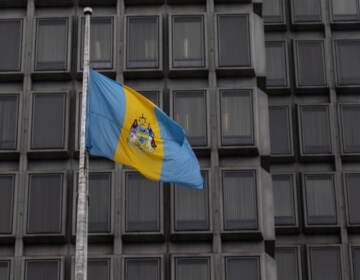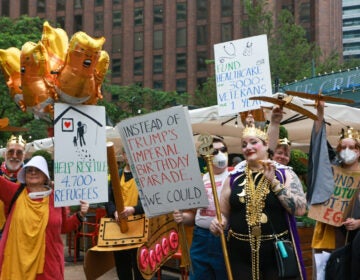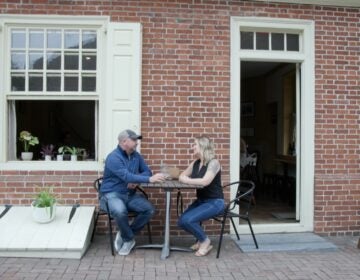‘Jawn’ is more than a noun. It connects us to who we are, beyond our city and region
The word ‘jawn’ can be used to replace any noun in a sentence, but the term is more than an interchangeable Philly word. It has a deeper meaning, writes Kae Lani Palmisano.
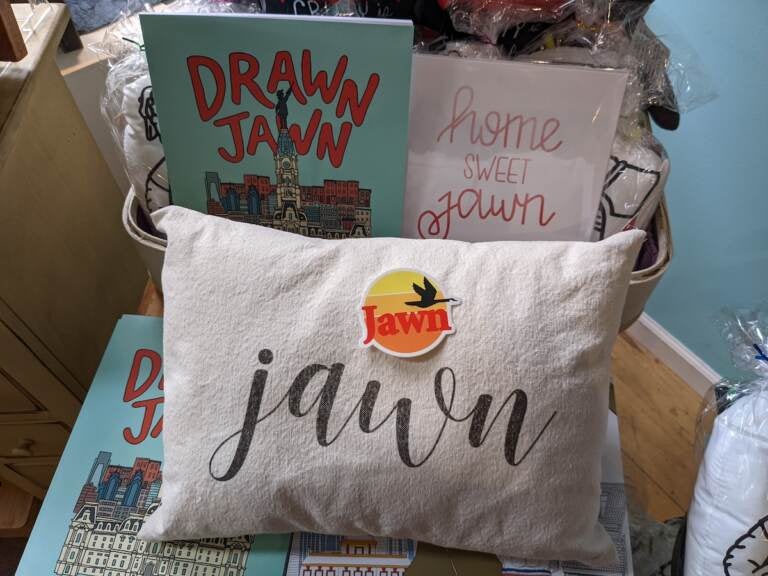
Pictured items include a jawn pillow from The Pillow Works, the Drawn Jawn coloring book by Katie Otte, a jawn sticker from South Fellini and a print that says "Homes Sweet Jawn" by Cricket Lane Studio. (Elizabeth Estrada/WHYY)
Philadelphia, we need to talk about how the word jawn has been used in recent years. If we keep going at the rate of a Jawn Morgan SEPTA bus barreling down Washington Avenue, we’re going to lose its more nuanced meaning.
Jawn is one of those words that has captured the imaginations of people over the last few years. It is hard to define, which is why people tend to just throw it into sentences or tack it on to other words to add a bit of Philly flare to their vocabulary. The ubiquitousness of jawn in our local consciousness has secured it as part of the Philadelphia brand, making it a point of pride — but also a divisive term in which locals fight over who is the most “Philly” in the room. But reducing jawn to “a Philly thing” perpetuates the idea that it’s just a quirky local colloquialism instead of a term that has a deeper, richer meaning.
The current understanding of the word jawn is that it can be used to replace any noun in a sentence. While that is true, it’s too simplistic of a definition. Jawn is so much more than just an interchangeable Philly noun — it’s an emphasis of the noun it’s replacing.
The emphasis of jawn is when you want to express that the noun is “extra” — it’s weird, it’s wild, it’s awesome — it can mean a lot of different things, but the context of the rest of the conversation will capture that.
Jawn is like the Philadelphia version of the French je ne sais quoi — “jawn sais quoi,” if you will. It has an intangible quality that is hard to express in any other word aside from jawn.
It’s both a noun and an abstract idea, it draws most of that context from the culture around it.
And jawn’s meaning isn’t just what the word is today — it’s also deeply connected to where the word came from.

A brief history of jawn
I hate to break it to you, Philly, but linguists agree that jawn actually comes from New York City and is derived from the word “joint,” which is deeply rooted in African American Vernacular English (AAVE), but its history goes back to around the time of emancipation.
Black Southerners used the term “juke joint” to refer to clubs and bars that were safe spaces for Black people to gather. Through the late 1800s, juke joints were where blues and ragtime music started to proliferate, giving way to other forms of music including jazz, boogie woogie dance music and, later, rock-and-roll.
During this time, joint was also a way to describe a place as seedy or dangerous. Places of ill repute like opium dens, gambling parlors and places where criminals met were referred to as joints. Joint’s divergent meaning also coincides with the rise of Jim Crow laws designed to disenfranchise, undermine and hold back Black people in the South. Laws that perpetuated “separate but equal” policies weren’t the only ways in which segregation was enforced. A racist dominant culture took, and in some cases still takes, aspects associated with Black culture and twists it to create a fictitious “boogie” man (side note — see how boogie woogie dance music morphed into boogie man, which can be a disparaging word for Black Americans).
It’s this hatred toward Black Americans in the South that leads to The Great Migration. From the 1910s through the 1970s, roughly six million Black Americans moved to the North, Midwest, and West to escape the oppression of the Jim Crow South. They brought with them their Southern Black culture which is why we find barbecue in Kansas City, why Chicago has its own style of jazz, and why New York City began to use the word joint.
By the mid-20th century, the word joint had gone through what’s called “semantic bleaching” where much of the word’s negative meaning was lost, and by the 1970s and 1980s, joint simply meant a place or a thing (a noun replacement, much like it is today).
Hip-hop culture and rap popularized the term joint which spread beyond New York City’s borders all along the east coast. This included Philadelphia where, according to Sandy Kingston of Philadelphia Magazine, joint evolved into jawn “because of the Southern drawl’s influence on Philly-tongue, not to mention that of African American Vernacular English, we tend to draw out our vowels and swallow our final consonants, so… no ’t’,” wrote Kingston.
It’s also around this time when joint and jawn take on main character energy.
Basically, referring to something as jawn wasn’t just a person, place or thing, but rather THE person, place or thing that diverges from the norm and has extraordinary qualities.
Whose jawn is it anyway?
Last week, I wrote a Twitter thread about the word jawn (the original inspiration for the piece you’re reading now). Overall my explanation of jawn resonated with people, but there was a small handful of people who were strangely possessive of jawn, and were quick to discredit my perspective for one simple reason: I am from New Jersey.
Ya got me! I was born in Camden, New Jersey in 1989 and lived in a mixed-race household with my grandparents, my uncles, and my mom. My grandfather, Claude Suggs, moved here from North Carolina (he was part of The Great Migration), and worked with my grandmother in Philadelphia as a street vendor.
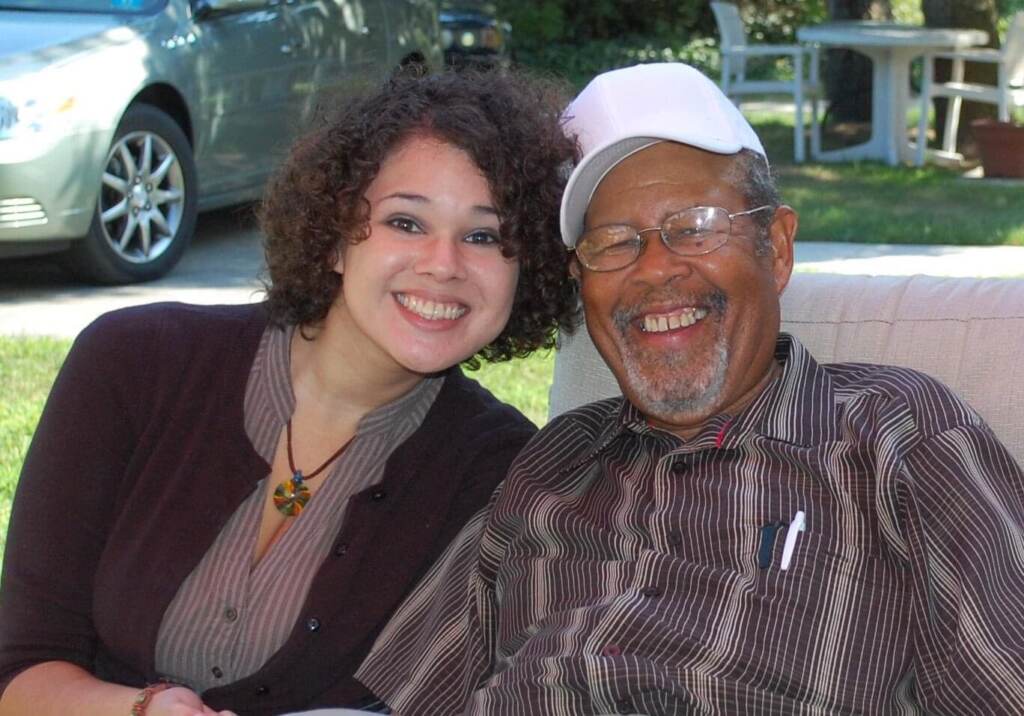
Despite being a white-passing Jersey girl, the Southern drawl and African American Vernacular English are part of my code-switching lexicon. Also, culture doesn’t stop at the borders old white men drew on a map. I’ve lived in different parts of the region, from Philadelphia all the way to the Pine Barrens, where people also shop at “Ack-uh-me” and get “wooder” from a “spicket.”
There is a divide between our understandings of jawn, but it’s not entirely a geographical one. It’s a cultural one. Jawn was a Black Philly thing before it was a Philly thing. Though jawn has become part of our region’s shared culture, it will always carry a deeper meaning to the Black community.
That’s because jawn is more than just a person, place or thing – it’s got history. It is a safe place to gather and be joyful despite being undermined by the dominant culture. Jawn hypes people up and is a term of encouragement, like how Funky Four Plus One calls each member of their group “the joint” in their song “That’s the Joint”.
Jawn has an unspoken language connected to it.
Part of it is understood by most people in the region, even the folks who hang jawnaments up for the holidays, eat something off the jawn menu, or wear jawn T-shirts (I own two). But there’s a whole other world of jawn that speaks to the people who had to preserve and protect the culture around it.
The magic of jawn is that, for some reason, there’s always an understanding of what it is referring to. That’s because jawn is shaped by the tonality, cadence, and vocabulary of African American Vernacular English. Just listen to how Questlove uses jawn in this explainer video promoting Summer of Soul referred to as “A Questlove Jawn,” which is reminiscent of how Spike Lee’s films are called “Joints”. The meaning changes, and that’s the point.
When you know the history behind jawn, understand where it comes from and recognize the community who brought meaning to it, you can better appreciate its more subtle meanings.
And that jawn just hits different.
Kae Lani Palmisano is the Emmy Award-winning host of WHYY’s Check, Please! Philly and of the digital series Delishtory. As a food and travel journalist, she has researched culinary traditions across four continents, from exploring the history of Geographical Indications throughout Europe to foraging with Māori in New Zealand.

Subscribe to PlanPhilly
WHYY is your source for fact-based, in-depth journalism and information. As a nonprofit organization, we rely on financial support from readers like you. Please give today.




